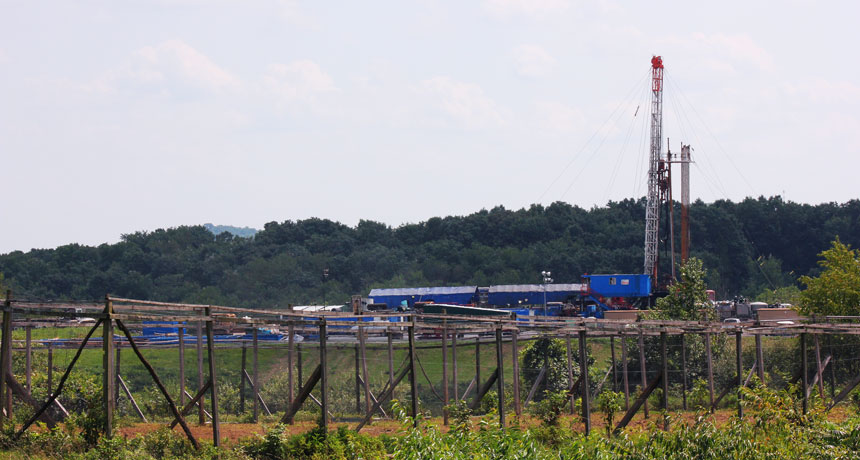20 April 2023–A decade’s worth of research at oil and gas operations in the central and eastern United States has confirmed that fluid injection from hydraulic fracturing and wastewater disposal can induce seismicity.
Now, data from hydraulic fracturing wells in eastern Ohio indicate that extraction activities also can influence the seismicity rate, according to a presentation at the Seismological Society of America (SSA)’s 2023 Annual Meeting.
During hydraulic fracturing, well operators inject a pressurized liquid into a rock layer after drilling vertically and often horizontally through the rock. The liquid breaks apart—fractures–the rock layer and allows natural gas or petroleum to flow out more freely. This process can induce seismic activity large enough for people to feel, possibly by increasing fluid pressures within the rock that help to unlock faults and allow them to slip.
When seismologists detected a flurry of seismicity last fall in eastern Ohio, however, there was no clear link to injection, said Michael Brudzinski of Miami University.
“The amount of seismicity kind of looked like patterns we would see when an injection operation was ongoing,” he explained. “However, when we asked the regulator what kind of activities were going on, he shared with us that there wasn’t anything new going on.”
Puzzled, Brudzinski and his colleagues began to look for other well processes that might influence seismicity. One idea they had was that “fluctuations in the amount of extraction from the reservoir might be influencing when seismicity is occurring,” said Brudzinski.
Because fracturing is so pervasive in newer wells, he explained, the amount of oil and gas that can be extracted “is large initially but it diminishes fairly quickly. So sometimes operators will stop extracting for a month or two, then start it up again, and when they start it up again it tends to produce a little bit better.”
Comparing seismic data to publicly available oil and gas operations records for the Ohio wells, the researchers saw that the unusual change in seismicity rates was associated with this “charge-up” process.
“When a particular well was temporarily halted in terms of their extraction, that’s when we see an increase in seismicity afterward,” said Brudzinski.

The researchers also noted an increase in the seismicity rate accompanying initial flowback, when liquid injected for fracturing makes its way back up to the surface when extraction starts after the fracturing process.
Extraction-related seismicity isn’t a new finding, Brudzinski said, noting studies of extraction earthquakes at the Groningen gas field in the Netherlands as one example.
“But what’s new for us is that we were not really thinking about the extraction process having an influence on seismicity in these cases where injection has been the primary cause of seismicity,” he said.
The earthquakes induced by extraction activities in this region are magnitude 2.6 or smaller—large enough to be felt but not damaging. The magnitude distribution of extraction-related earthquakes is similar to the distribution of earthquakes occurring when the wells were initially fractured.
This was surprising to Brudzinski and colleagues, who thought the extraction earthquakes might be smaller. But it suggests that the same fault activated in fracturing might be activated again during extraction, he said.
The flurry of extraction-related seismicity only lasts for a few days, and then decays over one to two weeks, compared to the several weeks to months of injection and accompanying seismic activity.
One of the bigger questions Brudzinski and his colleagues want to answer is whether they’ve discovered a unique situation in eastern Ohio, or whether extraction influencing seismicity rates is a more widespread phenomenon.
In other parts of the country where the scale of both fracturing and wastewater disposal is much larger, he said, it could be hard to detect this seismic signal of extraction.
“If we found that a few percent of the time they shut in wells and start them up again, and there’s an increase in seismicity, that would sort of suggest to me that we do need to look even in places where there’s more prevalent injection just to see if we can pick that signal up even in those places,” Brudzinski said.
